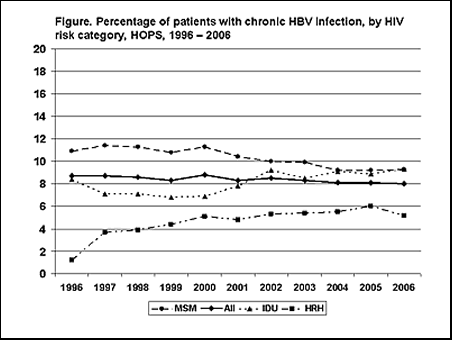
| Rate
of Chronic Hepatitis B among HIV Positive U.S. Patients in High, but Stable since
Mid-1990s Due to overlapping routes of transmission, many HIV positive people have been exposed to hepatitis B virus (HBV). While most are able to spontaneously clear HBV without treatment, the likelihood of developing chronic hepatitis B is higher in HIV positive compared with HIV negative individuals. As presented this week at the 48th International Conference on Antimicrobial Agents and Chemotherapy (ICAAC 2008) in Washington, DC, researchers calculated the prevalence of chronic HBV infection annually from 1996 through 2006 according to age, sex, race/ethnicity, and HIV risk factors among participants in the HIV Outpatient Study (HOPS), a U.S. multisite observational cohort study of HIV-infected patients. HBV prevalence was defined as the number of patients with positive hepatitis B surface antigen (HBsAg) or hepatitis B "e" antigen (HBeAg) or detectable HBV DNA divided by the number of patients tested for chronic HBV infection. Results
The investigators concluded that "The prevalence of chronic HBV infection in the HOPS [cohort] was unchanged over the past decade among patients in all demographic and HIV risk groups," although the overall prevalence was "20 times greater than national prevalence estimates" for the general HIV negative population (0.42%). "Although HBV infection treatment options now exist for coinfected patients, vaccination of persons at risk for HBV infection remains the most essential intervention," they emphasized.
CDC,
Atlanta, GA; Cerner Corp., Vienna,VA. |
The
material posted on HIV and Hepatitis.com about ICAAC 2008 and IDSA 2008 is not
approved by nor is it a part of ICAAC 2008 or IDSA 2008. |
![]()
